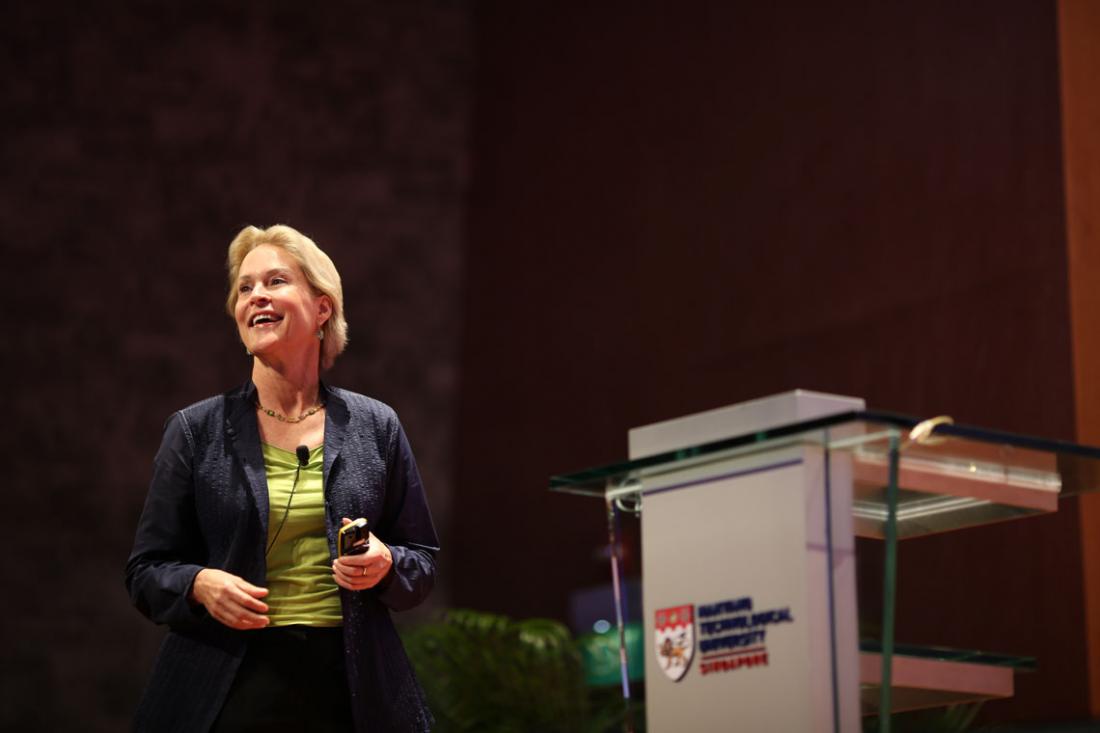Prof Frances Arnold, GYSS 2018
In the early 1990s, Professor Frances Arnold, who is now the Linus Pauling Professor of Chemical Engineering, Bioengineering and Biochemistry at the California Institute of Technology (Caltech) in the United States, pioneered a technique called directed evolution.
By introducing random mutations into a protein’s DNA code, scientists can coax a microbe into producing proteins with new properties. They can then comb through the results, select the useful ones, and repeat the process until they obtain new proteins that meet their needs.
Over the years, this technique has been used globally in laboratories to improve drug research and manufacturing, biofuels, crops, household goods such as detergents, sensors in diagnostics and many other products and sectors.
Prof Arnold, one of the speakers at the Global Young Scientists Summit 2018, which was held in Singapore from January 21 to 26, believes, however, that the best from directed evolution is yet to come.
In an interview ahead of the summit, she said: “I think that the next few years will bring us new drugs, agricultural chemicals and many products that we use in our daily lives being made cleanly and more efficiently using biology. We will also have products that we can’t even imagine now.”
In late 2016, for example, Prof Arnold led a team at Caltech in using directed evolution to create organo-silicon molecules, which are molecules that have both carbon and silicon chemically bonded together.
Companies now artificially produce such molecules for use in products ranging from pharmaceuticals to herbicides and computer and television screens, but their methods are expensive, often require precious metals and toxic solvents, and generate unwanted by-products that have to be removed.
By evolving proteins to produce the molecules biologically, firms could not only save money but also help the environment. “I’m talking a lot to pharmaceutical and chemical companies, because clean, biological routes to making their products is very attractive to them,” said Prof Arnold.
In fact, directed evolution has already helped pharmaceutical firms to improve the manufacturing process for two of the world’s best-selling drugs, Januvia and Lipitor, by reducing waste and improving yield. The former is used to treat Type 2 diabetes while the latter is used to lower blood cholesterol.
Prof Arnold, who is also director of Caltech’s Donna and Benjamin M Rosen Bioengineering Centre, has herself co-founded two companies, Gevo and Provivi, that have used directed evolution to improve the production of biofuels and non-toxic substitutes for pesticides in agriculture, respectively.
Other scientists are using directed evolution to study how enzymes evolve naturally, identify drug targets for diseases such as Chagas disease, the deadliest parasitic illness endemic to Latin America, create enzymes that can cut HIV out of infected cells, and more.
In 2016, Prof Arnold was awarded the Millennium Technology Prize, considered the Nobel Prize of technology, for her work in pioneering directed evolution.
In an interview with Technology Academy Finland, the organisation which confers the prize, she noted: “Directed evolution allows us to circumvent our inability to explain how mutations affect protein behaviour, much less to predict beneficial ones.
“The most beautiful, complex and functional objects on the planet have been made by evolution. We can use it to make things that no human knows how to design. Evolution is the most powerful engineering method in the world, and we should make use of it to find new biological solutions to problems.”
She added: “The field is expanding rapidly as we explore and demonstrate new opportunities for using biology, for example bacteria, to cure diseases, monitor and degrade pollutants or replace toxic pesticides.
“People are finding new applications for proteins and enzymes as we learn how to use evolution to create new ones. Inventive people will see possibilities for using biology to make whole new classes of molecules, materials, products and processes.”
Breaking science’s glass ceiling
In 2016, Professor Frances Arnold from the California Institute of Technology in the United States became the first woman to win the Millennium Technology Prize, regarded as the Nobel Prize in technology, for her work in pioneering directed evolution. The process mimics natural evolution to create new and better proteins, including enzymes, in the laboratory.
In an interview with Technology Academy Finland (TAF), which awards the prize, she said that her breakthrough moment came in the early 1990s, when she was frustrated by the failure of her efforts to improve enzymes.
“I decided to try thousands of experiments at once, because our single ones never succeeded. With my small team, I made thousands of mutations, all over the protein, and looked to see which ones made it better. We accumulated improvements over several generations to get to the desired function. I then saw that you could indeed change a protein and make it better for the things we want it to do,” she said.
Over the years, Prof Arnold has broken other glass ceilings in science. She was also the first woman to be awarded the prestigious Charles Stark Draper Prize for Engineering, and to be admitted to all three US National Academies (of sciences, engineering and medicine).
She said in the interview: “I think my timing was very lucky. I’m very grateful for the pioneering work done by the few, strong women who entered these fields before I did. They had a tough time getting jobs, being taken seriously by their colleagues and getting attention in a positive way. When I received my degrees, engineering departments were just realising that leaving half the population out of science and technology was a huge waste of brainpower.
“Science is not for everyone. It takes a lot of time and devotion to become really good, and the same is true for engineering. You have to love it. Still, I hope that young women can see themselves in my position someday, and see that one can have a rewarding career in science and technology.”



